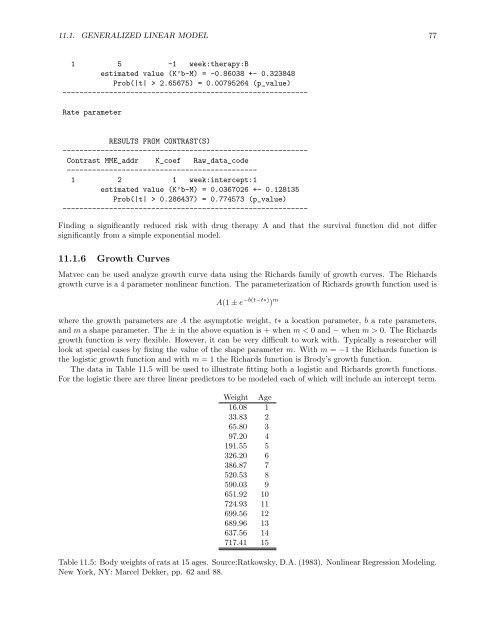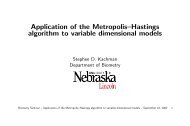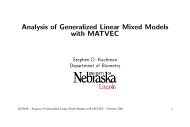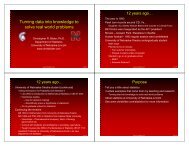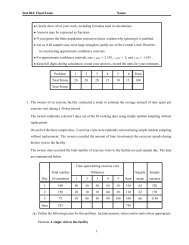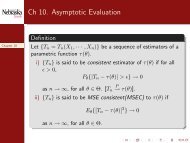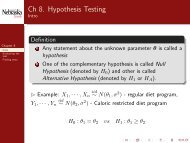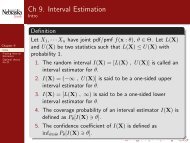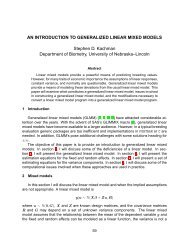Matvec Users’ Guide
Matvec Users' Guide
Matvec Users' Guide
- No tags were found...
Create successful ePaper yourself
Turn your PDF publications into a flip-book with our unique Google optimized e-Paper software.
11.1. GENERALIZED LINEAR MODEL 77<br />
1 5 -1 week:therapy:B<br />
estimated value (K’b-M) = -0.86038 +- 0.323848<br />
Prob(|t| > 2.65675) = 0.00795264 (p_value)<br />
----------------------------------------------------------<br />
Rate parameter<br />
RESULTS FROM CONTRAST(S)<br />
----------------------------------------------------------<br />
Contrast MME_addr K_coef Raw_data_code<br />
---------------------------------------------<br />
1 2 1 week:intercept:1<br />
estimated value (K’b-M) = 0.0367026 +- 0.128135<br />
Prob(|t| > 0.286437) = 0.774573 (p_value)<br />
----------------------------------------------------------<br />
Finding a significantly reduced risk with drug therapy A and that the survival function did not differ<br />
significantly from a simple exponential model.<br />
11.1.6 Growth Curves<br />
<strong>Matvec</strong> can be used analyze growth curve data using the Richards family of growth curves. The Richards<br />
growth curve is a 4 parameter nonlinear function. The parameterization of Richards growth function used is<br />
A(1 ± e −b(t−t∗) ) m<br />
where the growth parameters are A the asymptotic weight, t∗ a location parameter, b a rate parameters,<br />
and m a shape parameter. The ± in the above equation is + when m < 0 and − when m > 0. The Richards<br />
growth function is very flexible. However, it can be very difficult to work with. Typically a researcher will<br />
look at special cases by fixing the value of the shape parameter m. With m = −1 the Richards function is<br />
the logistic growth function and with m = 1 the Richards function is Brody’s growth function.<br />
The data in Table 11.5 will be used to illustrate fitting both a logistic and Richards growth functions.<br />
For the logistic there are three linear predictors to be modeled each of which will include an intercept term.<br />
Weight Age<br />
16.08 1<br />
33.83 2<br />
65.80 3<br />
97.20 4<br />
191.55 5<br />
326.20 6<br />
386.87 7<br />
520.53 8<br />
590.03 9<br />
651.92 10<br />
724.93 11<br />
699.56 12<br />
689.96 13<br />
637.56 14<br />
717.41 15<br />
Table 11.5: Body weights of rats at 15 ages. Source:Ratkowsky, D.A. (1983). Nonlinear Regression Modeling.<br />
New York, NY: Marcel Dekker, pp. 62 and 88.


